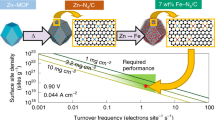Abstract
Improving the kinetics of O2 reduction on oxide surfaces is critical in many energy and fuel conversion technologies. Here we show that the acidity scale for binary oxides is a powerful descriptor for tuning and predicting oxygen surface exchange kinetics on mixed conducting oxides. By infiltrating a selection of binary oxides from strongly basic (Li2O) to strongly acidic (SiO2) onto the surface of Pr0.1Ce0.9O2-δ samples, it was possible to vary the chemical surface exchange coefficient kchem by 6 orders of magnitude, with basic oxides such as Li2O increasing kchem by nearly 1,000 times, with surface concentrations as low as 50 ppm impacting kchem. Strikingly, although the pre-exponential of kchem scales linearly with the acidity of the infiltrated binary oxide, there is nearly no change in the activation energy. The origin of these dramatic changes is proposed to arise from the systematic increase in electron concentration at the Pr0.1Ce0.9O2-δ surface with the decreasing acidity of the infiltrated binary oxide.

This is a preview of subscription content, access via your institution
Access options
Access Nature and 54 other Nature Portfolio journals
Get Nature+, our best-value online-access subscription
$29.99 / 30 days
cancel any time
Subscribe to this journal
Receive 12 digital issues and online access to articles
$119.00 per year
only $9.92 per issue
Buy this article
- Purchase on Springer Link
- Instant access to full article PDF
Prices may be subject to local taxes which are calculated during checkout





Similar content being viewed by others
Data availability
The datasets of conductivity relaxation analysed during the current study are available in the source files of this manuscript. All other data are available within the paper and its Supplementary Information files. Source data are provided with this paper.
References
Chueh, W. C. et al. High-flux solar-driven thermochemical dissociation of CO2 and H2O using nonstoichiometric ceria. Science 330, 1797–1801 (2010).
Kilner, J. A. & Burriel, M. Materials for intermediate-temperature solid-oxide fuel cells. Annu. Rev. Mater. Res. 44, 365–393 (2014).
Laguna-Bercero, M. A. Recent advances in high temperature electrolysis using solid oxide fuel cells: a review. J. Power Sources 203, 4–16 (2012).
Wei, Y., Yang, W., Caro, J. & Wang, H. Dense ceramic oxygen permeable membranes and catalytic membrane reactors. Chem. Eng. J. 220, 185–203 (2013).
Whittingham, M. S. Lithium batteries and cathode materials. Chem. Rev. 104, 4271–4301 (2004).
Montini, T., Melchionna, M., Monai, M. & Fornasiero, P. Fundamentals and catalytic applications of CeO2-based materials. Chem. Rev. 116, 5987–6041 (2016).
Wang, C., Yin, L., Zhang, L., Xiang, D. & Gao, R. Metal oxide gas sensors: sensitivity and influencing factors. Sensors 10, 2088–2106 (2010).
Barsan, N., Koziej, D. & Weimar, U. Metal oxide-based gas sensor research: how to? Sens. Actuators B 121, 18–35 (2007).
Jeong, D. S. et al. Emerging memories: resistive switching mechanisms and current status. Rep. Prog. Phys. 75, 076502 (2012).
Akinaga, H. & Shima, H. Resistive random access memory (ReRAM) based on metal oxides. Proc. IEEE 98, 2237–2251 (2010).
Adler, S. B. Factors governing oxygen reduction in solid oxide fuel cell cathodes. Chem. Rev. 104, 4791–4843 (2004).
Gao, Z., Mogni, L. V., Miller, E. C., Railsback, J. G. & Barnett, S. A. A perspective on low-temperature solid oxide fuel cells. Energy Environ. Sci. 9, 1602–1644 (2016).
Rupp, G. M., Kubicek, M., Opitz, A. K. & Fleig, J. In situ impedance analysis of oxygen exchange on growing La0.6Sr0.4CoO3-δ thin films. ACS Appl. Energy Mater. 1, 4522–4535 (2018).
Schaube, M., Merkle, R. & Maier, J. Oxygen exchange kinetics on systematically doped ceria: a pulsed isotope exchange study. J. Mater. Chem. A 7, 21854–21866 (2019).
Kubicek, M., Limbeck, A., Frömling, T., Hutter, H. & Fleig, J. Relationship between cation segregation and the electrochemical oxygen reduction kinetics of La0.6Sr0.4CoO3-δ thin film electrodes. J. Electrochem. Soc. 158, B727–B734 (2011).
Yokokawa, H., Tu, H., Iwanschitz, B. & Mai, A. Fundamental mechanisms limiting solid oxide fuel cell durability. J. Power Sources 182, 400–412 (2008).
Perry, N. H. & Ishihara, T. Roles of bulk and surface chemistry in the oxygen exchange kinetics and related properties of mixed conducting perovskite oxide electrodes. Materials 9, 858 (2016).
Chen, D. et al. Constructing a pathway for mixed ion and electron transfer reactions for O2 incorporation in Pr0.1Ce0.9O2–x. Nat. Catal. 3, 116–124 (2020).
Cao, Y., Gadre, M. J., Ngo, A. T., Adler, S. B. & Morgan, D. D. Factors controlling surface oxygen exchange in oxides. Nat. Commun. 10, 1346 (2019).
Wang, L., Merkle, R., Mastrikov, Y. A., Kotomin, E. A. & Maier, J. Oxygen exchange kinetics on solid oxide fuel cell cathode materials—general trends and their mechanistic interpretation. J. Mater. Res. 27, 2000–2008 (2012).
Jung, W. C. & Tuller, H. L. A new model describing solid oxide fuel cell cathode kinetics: model thin film SrTi1–xFexO3-δ mixed conducting oxides—a case study. Adv. Energy Mater. 1, 1184–1191 (2011).
Jung, W. & Tuller, H. L. Investigation of surface Sr segregation in model thin film solid oxide fuel cell perovskite electrodes. Energy Environ. Sci. 5, 5370–5378 (2012).
Opitz, A. K. et al. The chemical evolution of the La0.6Sr0.4CoO3-δ surface under SOFC operating conditions and its implications for electrochemical oxygen exchange activity. Top. Catal. 61, 2129–2141 (2018).
Rupp, G. M., Opitz, A. K., Nenning, A., Limbeck, A. & Fleig, J. Real-time impedance monitoring of oxygen reduction during surface modification of thin film cathodes. Nat. Mater. 16, 640–645 (2017).
Li, M. et al. Mechanism for the enhanced oxygen reduction reaction of La0.6Sr0.4Co0.2Fe0.8O3-δ by strontium carbonate. Phys. Chem. Chem. Phys. 19, 503–509 (2017).
Mutoro, E., Crumlin, E. J., Biegalski, M. D., Christen, H. M. & Shao-Horn, Y. Enhanced oxygen reduction activity on surface-decorated perovskite thin films for solid oxide fuel cells. Energy Environ. Sci. 4, 3689–3696 (2011).
Wagner, S. F. et al. Enhancement of oxygen surface kinetics of SrTiO3 by alkaline earth metal oxides. Solid State Ion. 177, 1607–1612 (2006).
Argirusis, C. et al. Enhancement of oxygen surface exchange kinetics of SrTiO3 by alkaline earth metal oxides. Phys. Chem. Chem. Phys. 7, 3523–3525 (2005).
Cheng, Y. et al. Enhancing oxygen exchange activity by tailoring perovskite surfaces. J. Phys. Chem. Lett. 10, 4082–4088 (2019).
Paige, J. M. et al. Surface modification of SOFC cathodes by Co, Ni, and Pd oxides. Solid State Ion. 341, 115051 (2019).
Tsvetkov, N., Lu, Q., Sun, L., Crumlin, E. J. & Yildiz, B. Improved chemical and electrochemical stability of perovskite oxides with less reducible cations at the surface. Nat. Mater. 15, 1010–1016 (2016).
Sasaki, K. et al. Chemical durability of solid oxide fuel cells: influence of impurities on long-term performance. J. Power Sources 196, 9130–9140 (2011).
Chen, T., Harrington, G. F., Masood, J., Sasaki, K. & Perry, N. H. Emergence of rapid oxygen surface exchange kinetics during in situ crystallization of mixed conducting thin film oxides. ACS Appl. Mater. Interfaces 11, 9102–9116 (2019).
Smith, D. W. An acidity scale for binary oxides. J. Chem. Educ. 64, 480–481 (1987).
Ganeshananthan, R. & Virkar, A. V. Measurement of surface exchange coefficient on porous La0.6Sr0.4CoO3-δ samples by conductivity relaxation. J. Electrochem. Soc. 152, A1620–A1628 (2005).
Cabot, A. et al. Analysis of the noble metal catalytic additives introduced by impregnation of as obtained SnO2 sol–gel nanocrystals for gas sensors. Sens. Actuators B 70, 87–100 (2000).
Egger, A., Bucher, E., Yang, M. & Sitte, W. Comparison of oxygen exchange kinetics of the IT-SOFC cathode materials La0.5Sr0.5CoO3-δ and La0.6Sr0.4CoO3-δ. Solid State Ion. 225, 55–60 (2012).
Miessler, G. L., Fischer, P. J. & Tarr, D. A. Inorganic Chemistry (Pearson, 1991).
Lu, Q. et al. Surface defect chemistry and electronic structure of Pr0.1Ce0.9O2-δ revealed in operando. Chem. Mater. 30, 2600–2606 (2018).
Chueh, W. C. et al. Highly enhanced concentration and stability of reactive Ce3+ on doped CeO2 surface revealed in operando. Chem. Mater. 24, 1876–1882 (2012).
Portier, J., Poizot, P., Tarascon, J.-M., Campet, G. & Subramanian, M. A. Acid–base behavior of oxides and their electronic structure. Solid State Sci. 5, 695–699 (2003).
Bishop, S. R., Stefanik, T. S. & Tuller, H. L. Defects and transport in PrxCe1–xO2-δ: composition trends. J. Mater. Res. 27, 2009–2016 (2012).
De Souza, R. A. Limits to the rate of oxygen transport in mixed-conducting oxides. J. Mater. Chem. A 5, 20334–20350 (2017).
Guo, X. & Waser, R. Electrical properties of the grain boundaries of oxygen ion conductors: acceptor-doped zirconia and ceria. Prog. Mater. Sci. 51, 151–210 (2006).
Mebane, D. S. & De Souza, R. A. A generalised space–charge theory for extended defects in oxygen-ion conducting electrolytes: from dilute to concentrated solid solutions. Energy Environ. Sci. 8, 2935–2940 (2015).
Zhao, L., Perry, N. H., Daio, T., Sasaki, K. & Bishop, S. R. Improving the Si impurity tolerance of Pr0.1Ce0.9O2-δ SOFC electrodes with reactive surface additives. Chem. Mater. 27, 3065–3070 (2015).
Grubel, K., Brennessel, W. W., Mercado, B. Q. & Holland, P. L. Alkali metal control over N–N cleavage in iron complexes. J. Am. Chem. Soc. 136, 16807–16816 (2014).
Jinkawa, T., Sakai, G., Tamaki, J., Miura, N. & Yamazoe, N. Relationship between ethanol gas sensitivity and surface catalytic property of tin oxide sensors modified with acidic or basic oxides. J. Mol. Catal. A 155, 193–200 (2000).
Acknowledgements
This research was primarily supported by the US Department of Energy (DOE), National Energy Technology Laboratory (NETL), Office of Fossil Energy under Award no. DE-FE0031668—Self-Regulating Surface Chemistry for More Robust Highly Durable Solid Oxide Fuel Cell Cathodes. Supplementary support was provided by the US DOE, Office of Science, Basic Energy Sciences (BES), under Award no. DE-SC0002633—Chemomechanics of Far-From-Equilibrium Interfaces (XPS studies). G.F.H. acknowledges support from a Kakenhi Grant-in-Aid for Encouragement of Young Scientists (B) Award (no. JP18K13992) (TEM studies). Thanks go to A. Grimaud and D. Kalaev for helpful discussions.
Author information
Authors and Affiliations
Contributions
C.N. suggested the original idea. C.N. and H.L.T. designed the experimental protocol. C.N. prepared the samples, built the experimental set-up and performed the conductivity relaxation measurements. G.F.H. prepared the lamellae for TEM, performed the TEM measurements and computed the defect model used to interpret the results. C.T. prepared and measured the samples by XPS. C.T. and B.Y. performed the analysis of the XPS measurements and interpreted the results. T.D. performed the Raman spectroscopy measurements and interpreted the results. H.L.T. supervised the work and provided guidance throughout the project. C.N. and H.L.T. wrote the manuscript. All the co-authors discussed the results and helped to revise the manuscript.
Corresponding author
Ethics declarations
Competing interests
The authors declare no competing interests.
Additional information
Publisher’s note Springer Nature remains neutral with regard to jurisdictional claims in published maps and institutional affiliations.
Supplementary information
Supplementary Information
Supplementary Notes 1–9, Figs. 1–11, Equations 1–8 and Table 1.
Source data
Source Data Fig. 3
Unprocessed conductivity relaxation profiles for all infiltrated samples.
Source Data Fig. 4
Unprocessed conductivity relaxation profiles for each increment of Li infiltration.
Rights and permissions
About this article
Cite this article
Nicollet, C., Toparli, C., Harrington, G.F. et al. Acidity of surface-infiltrated binary oxides as a sensitive descriptor of oxygen exchange kinetics in mixed conducting oxides. Nat Catal 3, 913–920 (2020). https://doi.org/10.1038/s41929-020-00520-x
Received:
Accepted:
Published:
Issue Date:
DOI: https://doi.org/10.1038/s41929-020-00520-x
This article is cited by
-
Engineering surface dipoles on mixed conducting oxides with ultra-thin oxide decoration layers
Nature Communications (2024)
-
Back to basics: synthesis of metal oxides
Journal of Electroceramics (2023)
-
The Fermi energy as common parameter to describe charge compensation mechanisms: A path to Fermi level engineering of oxide electroceramics
Journal of Electroceramics (2023)
-
Reversely trapping atoms from a perovskite surface for high-performance and durable fuel cell cathodes
Nature Catalysis (2022)
-
Accelerating oxygen surface exchange
Nature Catalysis (2020)



